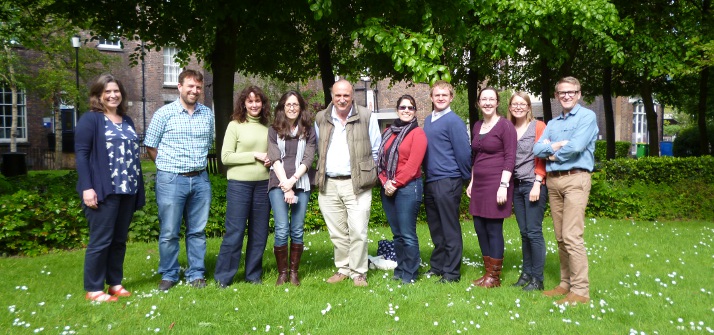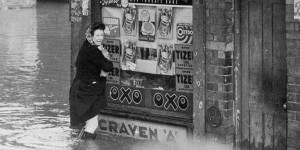
May 30, 2014, by Georgina
Now we are six (months old)
We are now six months into our research project and realising the scale of the undertaking we have set ourselves. At our recent team meeting, fueled by Lucy’s lemon cake and with the splendid panorama of the Liverpool skyline as a backdrop, we spent two days reporting on activities, discussing our progress and our strategy for the next stages. Work has begun in the multiple archives across our case study areas, with collections in Nottingham, Leicester, Derbyshire, Shrewsbury, Birmingham, Norfolk, Devon and Cornwall, being consulted. Research in the national archives and libraries (the National Archives of Wales, the Met Office and the Wellcome Trust) is underway and there have been fruitful exchanges with archivists in the Hebrides where we hope to begin work in early 2015.
Members of the team have spoken about their work on National TV, national and local radio, have delivered public lectures and plenaries and have received coverage in various local and popular history magazines. The development of our TEMPEST database is progressing well and our website is receiving a good number of hits. We are publicising our project through social media by tweeting (twitter @weather_extreme), blogging, and through our own facebook page. www.facebook.com/weatherextremes.
In short, much progress has been made.
As our blogs are demonstrating, our archival research is leading us to engage with a very diverse range of materials of both a qualitative and quantitative nature, from historical rainfall records to thermometer books, from weather observations within diaries to personal diaries of everyday activities which include anecdotal and/or incidental weather observations or comments. Team members are searching through detailed accounts of dramatic events as well as personal correspondence that refer to such events in passing. We are ploughing through estate collections and through the papers, deeds, legal records associated with key estate owners, through gardener’s diaries and records and shopkeeper’s journals and have also started to investigate the work of historical figures who, like us, found fascination in charting and collating the history of extreme events across the UK.
… and what is all this telling us?

Floods in The Meadows, Nottingham (1947) (The University of Nottingham Archives and Special Collections)
All such material is shedding light on the timing and implications of extreme events in various locations in each of our case study regions. It’s still early days in terms of evaluating some of these records, and also in terms of entering the data into our database. Yet it is clear to us that extreme and unusual weather events over recent centuries have regularly disrupted the way people live and interact with their environment and with each other, and have continually tested the resilience and resourcefulness of communities affected by them. We have stories of extreme weather resulting in mail delays, travel disruption and general inconvenience, through to crop loss, agricultural hardship and poverty; from drowning (humans and livestock), to building damage and bridge collapses; from tree and timber losses to agricultural experimentation and trialing of different crops. We are also starting to collect information that speaks to individual, collective and institutional responses from moral economic responses and donations from benefactors, to rental adjustments and tax relief (or increases). Some documents illustrate how communities came together in solidarity through ‘social capital’ responses, whether this is in the form of collective efforts to build or restore flood defences or through the sharing and distribution of essential resources during life threatening flood events.
Such extremes hold an unusual position in shaping and framing people’s lives. We are seeing how the weather punctuates daily routines through the work of various diarists whom we have encountered so far, but equally how the extremes can be picked out or indeed are picked out by the diarists themselves among more mundane or ‘everyday’ weather.
The work is helping us to question what is meant by the term extreme and how this varies across different places, regions, periods and people. We are identifying how people perceived and understood weather extremes and how droughts, floods, storms, extreme cold or heat become inscribed into the social and community memory, occasionally alongside other notable unusual or rare phenomena such as earthquakes or comets. Some events, or at least their impacts, provided a focus for public spectacle, while others, particularly floods, tended to be recalled almost as historical benchmarks against which other, later events are compared. We are also starting to identify how such events may have been materially inscribed into the built environment as well as into cultural memory, an aspect of the work which looks set to be of considerable value for our project partner, English Heritage.
The archives are presenting us with information that poses interesting links between weather events and public, animal and even crop health. Even though identifying the causal associations between extreme events and health remains a major challenge, the potential links drawn by diarists such as Woolley or Pegge Burnell to disease and wellbeing are of considerable value in thinking about how these relationships may have been conceptualised in the past.
The people that we are encountering within the archival materials are no less interesting and in fact, our approach is helping us build up a biographical picture of the figures who were affected or threatened by weather events, and about those who also recorded the weather, what they chose to record, how and also why and for what purpose. The project is in fact coming to life through these personalities and their stories.
Pointers and feedback
We have been fortunate in receiving some useful feedback from members of the public in response to blogs, the website and short pieces in local history publications (many thanks). We would be delighted to continue to hear from you if you know of other links worth exploring.
We are open to all kinds of input, thoughts and memories and materials, from newspapers and photos to literary references, which leads me finally to an anecdote from home (that helped with the title for this blog post). He’s not six yet (but not far off 5, as he likes to remind me) but in conversation with my eldest son, I found myself trying to explain the ‘nuts and bolts’ of our project- no easy task it has to be said. He pointed me toward the following quote, arguably a piece of extreme weather literature, courtesy of A A Milne:
“It’s snowing still,” said Eeyore gloomily.
“So it is.”
“And freezing.”
“Is it?”
“Yes,” said Eeyore. “However,” he said, brightening up a little, “we haven’t had an earthquake lately.”
― A.A. Milne
I just need to work out how to enter this one into our database…..

Loved that quote! Proper research assistant work that!
Yes, it made me smile too, good work!
It’s funny, extreme weather seems to crop up in bed time stories in our house too – tales of farmers pulling sheep from snow drifts (just like one of our Welsh diarists, Joseph Jenkins, described in March 1867) and in the wonderful Moomin stories. There must be a spin-off project in there somewhere!